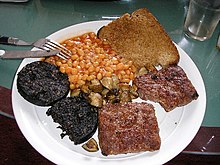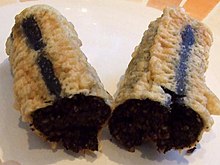Black pudding


Black pudding (Swedish: blodpudding, Estonian: verivorst, Finnish: mustamakkara, French: boudin noir, Spanish: morcilla and Portuguese: morcela) is a type of blood sausage commonly eaten in England, Scotland, France, Slovenia, Italy, Finland, Croatia, Hungary, Poland, Ireland, Sweden, Estonia, Spain, Portugal, Latvia and Lithuania. It is generally made from pork blood and a relatively high proportion of oatmeal.
Savoury
Black pudding is often grilled, fried, baked or boiled in its skin. It can be eaten cold as it is cooked in production. It was occasionally flavoured with pennyroyal, differing from continental European versions in its relatively limited range of ingredients and reliance on oatmeal and barley instead of onions or chitterlings to absorb and be mixed with the blood.[1]
In the United Kingdom,[2] black pudding is considered a delicacy in the Black Country, the West Midlands, Stornoway, the North West, and especially in Lancashire (in towns such as Bury), where it is traditionally boiled and served with malt vinegar out of paper wrapping.[3] The Stornoway black pudding, made on the Western Isles of Scotland, has been granted Protected Geographical Indicator of Origin status.
Black puddings are also served sliced and fried or grilled as part of a traditional full breakfast in much of the UK and Ireland, a tradition that followed British and Irish emigrants around the world. Black pudding is now part of the local cuisine of the Canadian provinces of Nova Scotia and Newfoundland and Labrador.[4]
In Spain, the most famous is the "morcilla" made at Burgos, in two varieties: cilindrical and gut-shaped, with blood, rice, onion and spices. There are other similarly famous kinds being made at Asturias (slightly darker and smaller, used for bean and chickpea stews) and León (no-rice grilled & spread on toasted bread). Other less popular varieties may add cumin to the pudding mixture, but this is not a standard practice. The cooking method for consumption is typically done fried, stewed, grilled or roasted, and usually sliced in one-finger-thick wheelettes ("rodajas"). There are many derivative foods made from morcilla, such as omelettes, stuffed red pepper, puff pastry, pizza, flavoured nachos and a range of fillings for different dishes.
See also
References
- ^ Jaine, T. and Davidson, A. The Oxford companion to food, OUP, 2006, p.104
- ^ "The Black Pudding". The English Breakfast Society. Retrieved 6 January 2014.
- ^ Lancashire and Cheshire Regional Dishes, accessed 30 April 2010
- ^ "Marystown man enjoys making traditional Newfoundland fare". Southern Gazette. Retrieved Oct 2008.
{{cite web}}: Check date values in:|access-date=(help)
